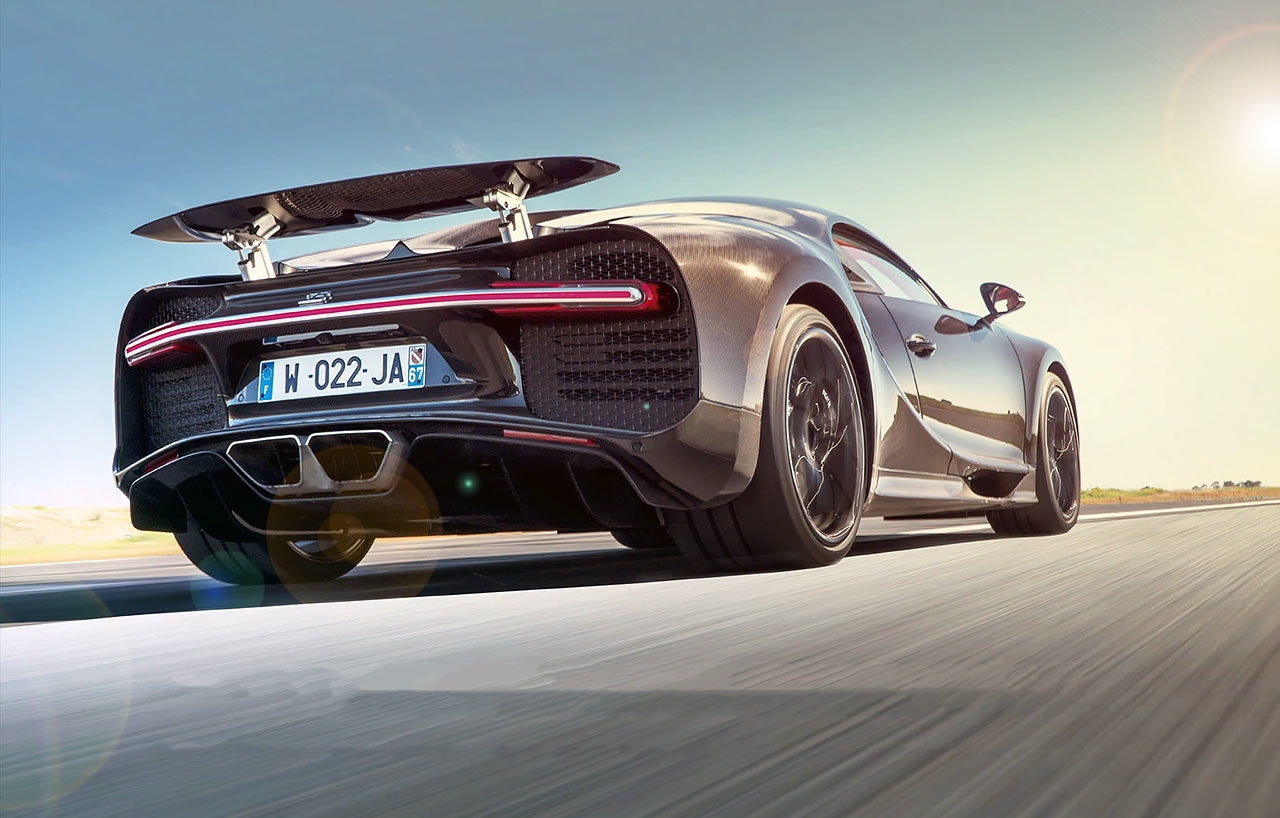
Hypercar version 2.0 – 2017 Bugatti Chiron 1479hp/1103kW. The wait is over as we uncage the insane new speed king. The numbers are astonishing – and quite frightening – but has the Veyron’s successor remedied that car’s lack of involvement? There has never been a production car with a higher output than the Chiron’s mind-blowing 1479bhp/1103kW. What does it feel like to have that much power under your right foot. Here’s we find out. Text by Richard Meaden.
It’s the speedo that gets you. For a moment you can’t quite believe your eyes. Do those numbers really read all the way around to 500km/h? The audacity and absurdity of it truly takes your breath away, but then that’s always been VW’s 21st century mission for Bugatti. To create cars that force you to reappraise what you thought was possible. To rewrite the rules.
If I’m honest, I always struggled with the Veyron. It was expressly created to chase big numbers and appeal to ultrahigh-net-worth individuals; people with more money than they know what to do with, buying cars they don’t know what to do with. This said, of course I was excited when I got the chance to drive one. And yes, it was madly powerful, rampantly fast and laughably easy to drive. But it was also a cold character. One that didn’t seduce me or leave a lasting impression, other than at the effort it must have taken to expunge the emotion from what was at the time the world’s fastest production car.
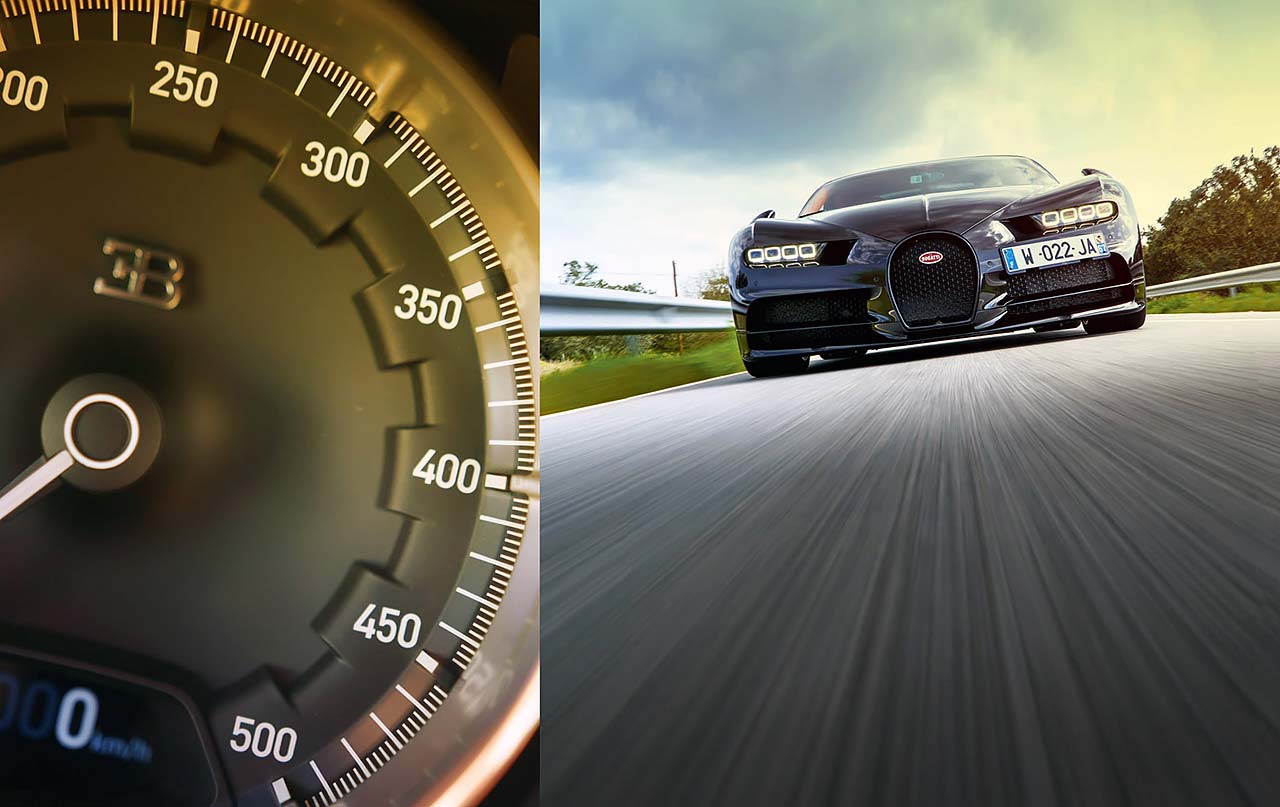
2017 Bugatti Chiron speedo
So why am I more excited by the Chiron? Because Bugatti recognised that whatever followed the Veyron had to address those issues. Not the customer profile, or even the obsession with setting blistering new benchmarks. All that stuff goes with the territory. No, what would be addressed was the touchyfeely stuff. The shades of grey that are needed to create a truly three-dimensional driving experience. The things that, if done brilliantly, will make the Chiron an event at any speed, and a car you want to thread through corner after corner as badly as you crave a long piece of straight road with no speed limits.
Things get off to a good start with the styling. The Chiron is unmistakeably a Bugatti, but there’s more intrigue and attitude. I love the eight-eyed stare and the huge, sweeping arc that defines the flanks. The brutally chopped tail is packed with drama, whether it’s the full-width tail light with its onepiece alloy surround machined from a 200kg billet of material to form this exquisite 1kg piece of automotive jewellery, the gargantuan rear wing that doubles as an air brake, or the sheer volume of hot air that vents through the massive area of mesh. And then there’s the 8.0-litre, quad-turbocharged W16 filling the belly of the beast, open to the elements beneath its slashcut engine cover.
The interior sustains that drama, thanks to another arc that bisects the cockpit, looping back from the headlining, down the rear bulkhead and in along the centre console. It doesn’t segregate driver from passenger, but it creates an unusually intimate environment. One that gives each their own space and somehow focuses attention out through the windscreen. What frame of reference do you use to assess a car that develops 1103kW and 1600Nm, accelerates from a standstill to 200km/h in less time than a quick car hits 100km/h and has its top speed electronically limited to 420km/h?
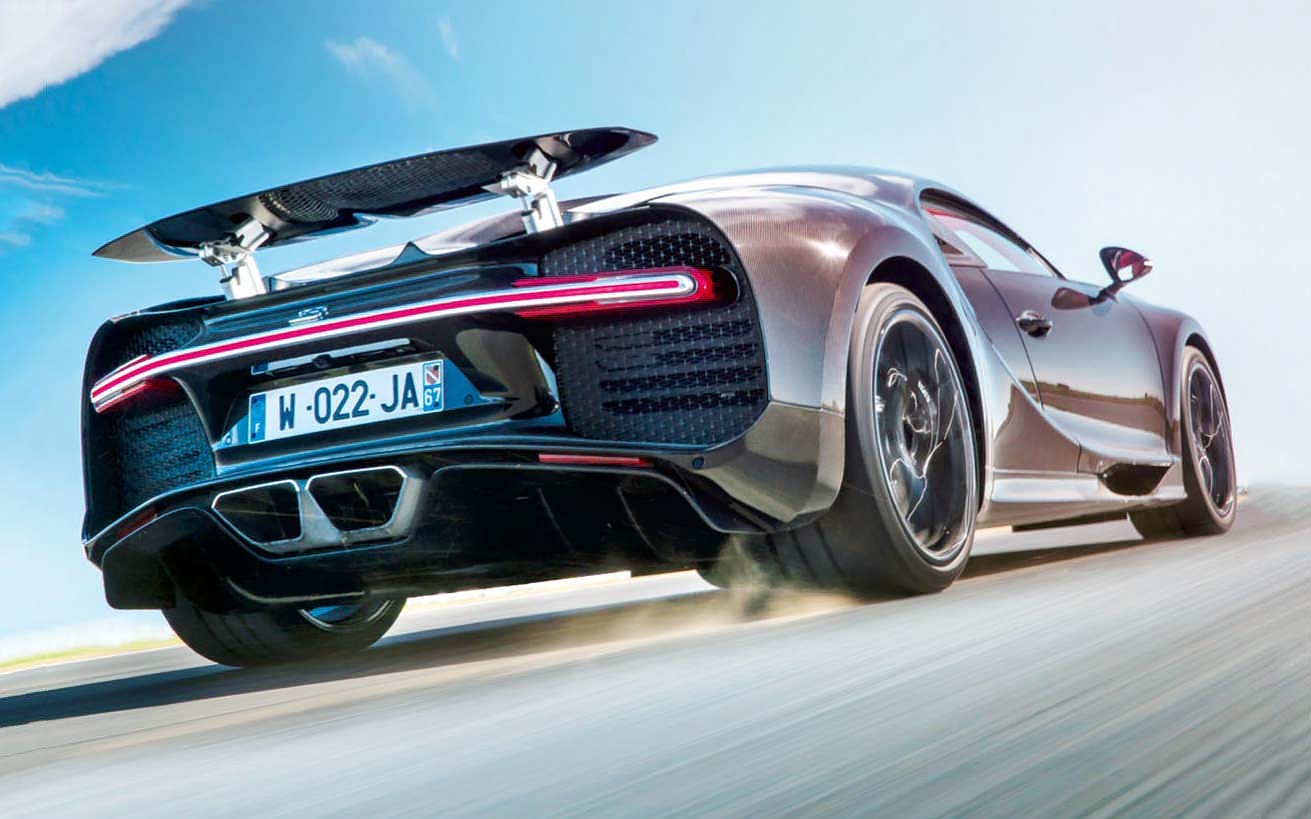
2017 Bugatti Chiron road test
The simple answer would be to look back at the Veyron, but even modern Bugatti’s first effort pales when compared with the Chiron. As the engineers tell us at the two-hour technical briefing, ‘‘We couldn’t just go and get parts out of a box in the stores. We had to make everything.’’ That’s why, even though the Veyron set so many benchmarks, virtually every key component required replacing, redesigning or re-engineering to add strength and save weight for the Chiron. One of the most impressive examples is the crankshaft, which had to be much stronger but is now 1.4kg lighter thanks to new machining processes. The only component allowed to be heavy is the front badge, which is made from solid silver.
So don’t be fooled into thinking the Chiron is propelled by a Veyron engine with the wick turned up a bit. Yes, it’s an 8.0-litre W16 force-fed by a quartet of turbos, but most of the internals are all-new. To produce the power increase, the turbos are much bigger than those fitted to the Veyron. Ordinarily this would mean increased turbo-lag, but the engineers have mitigated this by blowing all the exhaust gases through two of the turbos below 3800rpm, then feeding all four beyond that point. The conrods are stronger and lighter. Everything has been subjected to painstaking scrutiny in order to strike a more efficient balance between strength and mass.
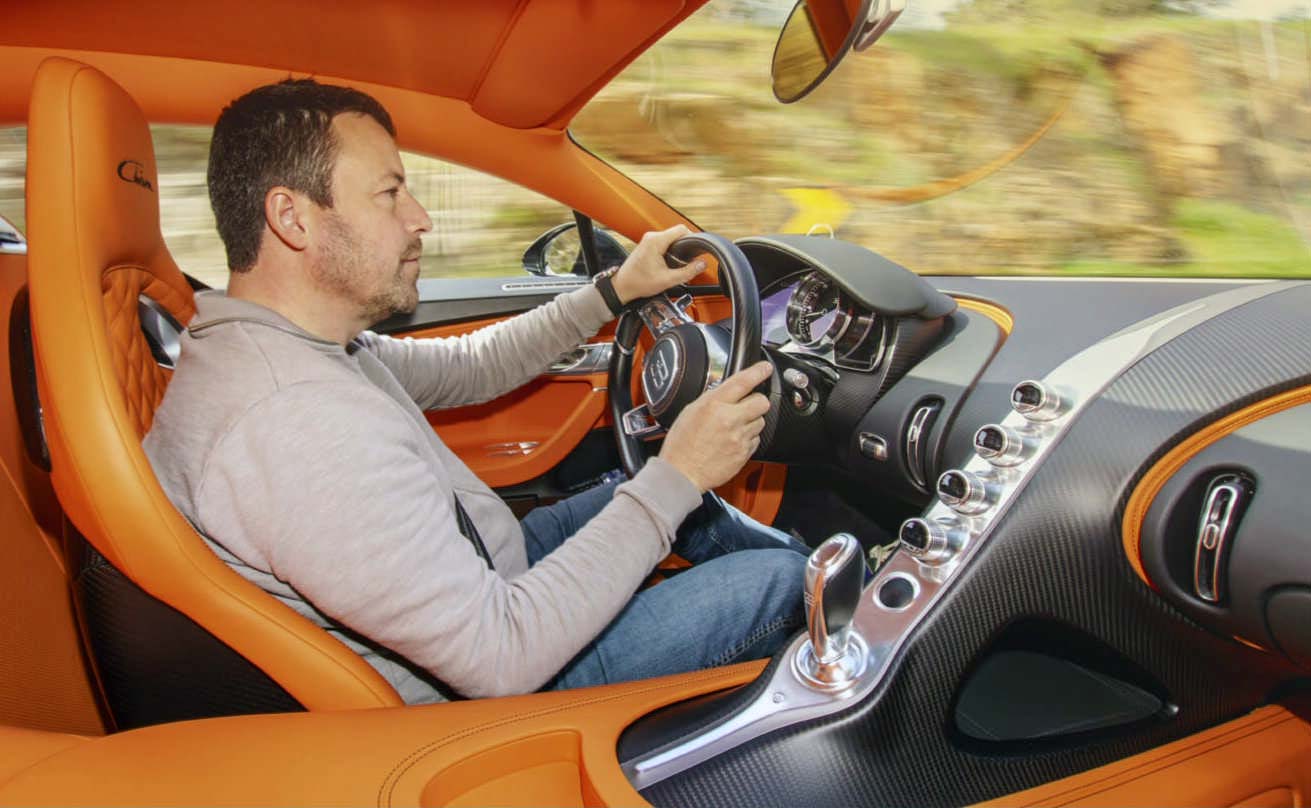
2017 Bugatti Chiron road test
The result is huge gains in power and torque over the Veyron, which itself mustered 736kW in its original guise, rising to 882kW in later versions. The Chiron’s 1103kW peak arrives at 6700rpm, while its 1600Nm is available from 2000rpm all the way to 6000. Those are truly astonishing figures and the key to acceleration times that are no less mind-blowing: from a standstill 100km/h arrives in less than 2.5 seconds; 200km/h in 6.5; 300km/h in 13.6. Word is, were Bugatti to remove the electronic speed-limiter altogether the Chiron would touch 450km/h. As ever, tyres are the limiting factor. Hence the 420km/h upper limiter and the 380km/h ‘everyday limiter’. Andy Wallace – veteran of the celebrated McLaren F1 vmax run – describes counting to eight when running the Chiron towards that 420km/h limit, for that’s about as long as the tyres can stand before heat and centrifugal force threaten to tear them apart.
Entire books could be written on the technology contained within the Chiron. The bodywork is super-thin, super-strong carbonfibre with the finest sliver of aluminium honeycomb sandwiched at its core. The structure beneath uses the same technology to save weight and add strength. Torsional rigidity is 50,000Nm per degree, flexural rigidity approximately 0.25mm per tonne. That’s comparable to a current LMP1 car. The Chiron also meets worldwide safety standards, rather than relying on small-volume loopholes.
It has a fully adaptive chassis that optimises damping, ride height, aerodynamics, steering and powertrain to deliver the right blend of compliance, stability, agility and responsiveness across its unprecedented performance envelope. Michelin developed new tyres to cope with the demands of running at 420km/h, an aerospace rig being used to simulate the stresses. The carbon-ceramic brake discs are 20mm larger (now 420mm front and 400mm rear) and 2mm thicker. They are gripped by all-new forged aluminium calipers – eight-piston at the front, six-piston at the rear – and built to an asymmetrical design to help dissipate the incredible amount of energy generated when slowing the 1995kg Chiron from high speeds. A new design of heat shield guides air through the discs to further aid cooling, by as much as 50 per cent. They should even stand track use; something the Veyron’s stoppers struggled with.
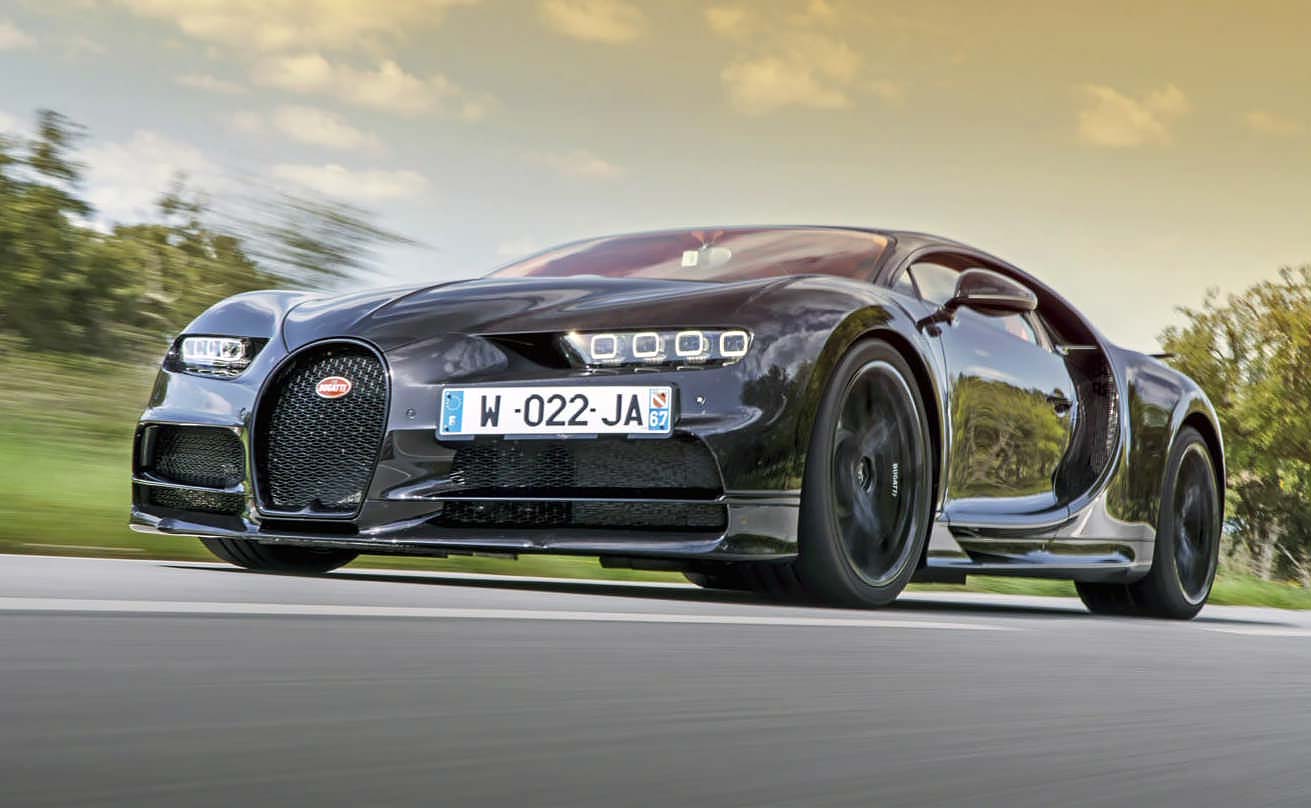
2017 Bugatti Chiron road test
Down to the nitty gritty, then. What’s it like to drive? With the Veyron, it was almost as though Bugatti skipped this allimportant aspect, such was the focus on hitting those onceincredible power and performance benchmarks, and making sure it was reliable and driveable. This time around, Bugatti knew the Chiron had to back up the numbers with feel and emotion. And pretty much straight away you sense the connection and detail through the steering that development driver Loris Bicocchi worked so hard to perfect. Of course there’s tonnes of grip and unshakeable traction, but it’s the way you can now feel and sense how much you’re using and how much is left that marks the Chiron out as something special.
Its weight and that endless plateau of torque mean it’s not a flighty, fighty machine in the style of a P1 or LaFerrari, but it manages to feel both planted and calmly agile. More hyper-GT than hyperactive hypercar. Given Bugatti owners tend to have extensive collections of cars (an average of 41, we’re told), that’s a smart move, for it’s what continues to separate Bugattis from the rest. The Chiron even has a luggage hold, just big enough for a carry-on bag. Though as someone pointed out at the briefing, it’s doubtful a Chiron owner will be arguing with Jetstar personnel at check-in.
The steering is extremely well-judged in terms of response, so you’re soon guiding the Chiron instinctively. Accurately, too, which is always a confidence-booster. It feels a size smaller than it is. The problem, if you can call it such, is the range and accessibility of the performance. A squeeze of the throttle sends you surging down the road with the insistence of an avalanche. Give it a push to the carpet and there’s the briefest sense of the W16 filling its lungs and then you simply punch from where you were to where you were looking, waaaaay down the straight. It’s more like matter transfer than conventional acceleration. Unfortunately it seems to leave your stomach and your senses somewhere in its wake, at least until your brain begins to recalibrate. Nothing in my experience connects the corners quite like this. It’s monstrous. Thankfully the brakes are more than up to the task of stopping the thing. Those super-trick cooling fins within the disc shrouding work a treat; combined with the air brake, they mean you’re in seatbelt freefall when you brake from big speeds. All this stopping power comes with plenty of feel and finesse at lower speeds. The seven-speed DSG transmission, meanwhile, is super-smooth and virtually instantaneous. Left to shift by itself you’re always in the meat of the torque – hard not to be, truth be told – but it’s also satisfying to flip the paddles yourself.
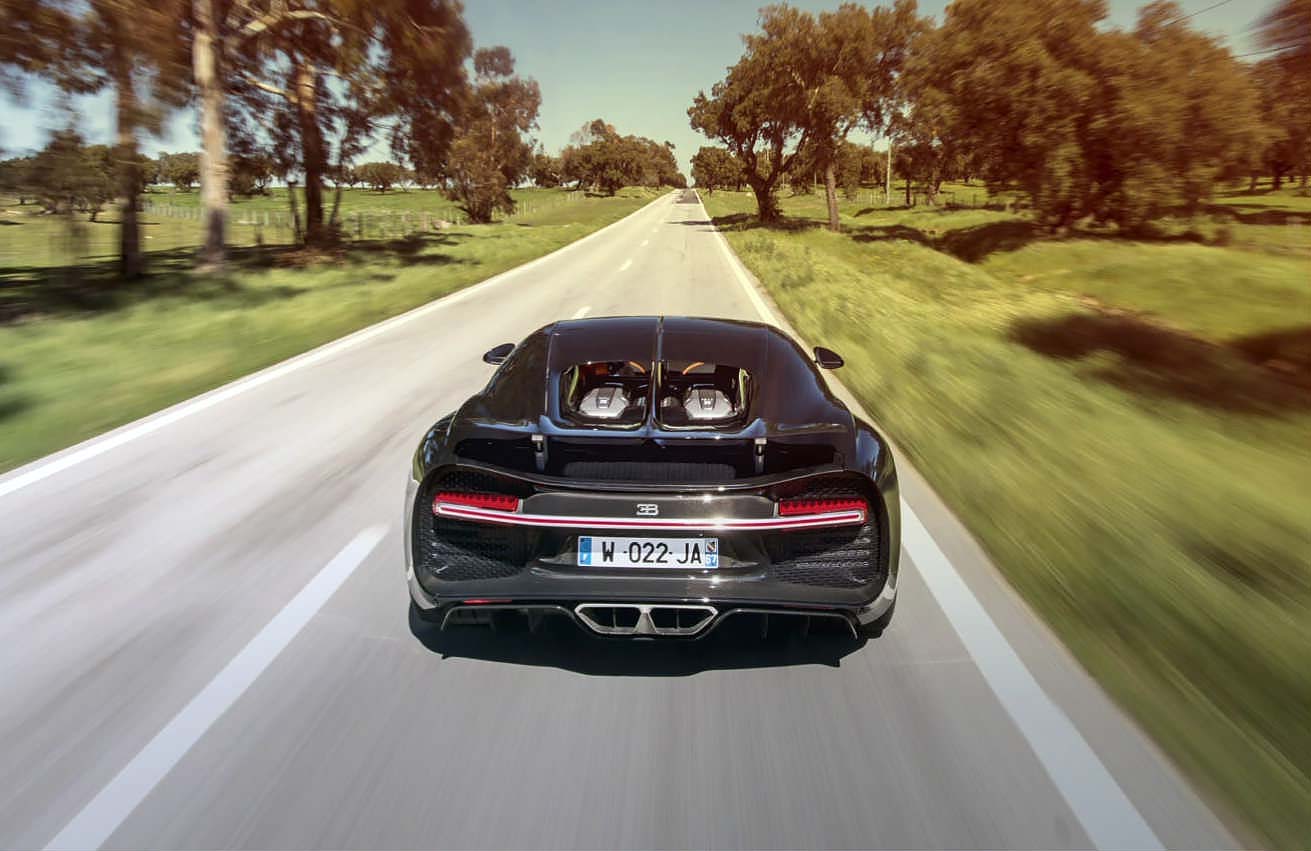
2017 Bugatti Chiron road test
There are four dynamic modes, plus vmax mode (Max speed), which is accessed by a secondary key mounted on the driver’s door sill. This preps the car for a full 420km/h charge, though it defaults back to 380km/h if you apply more than a few degrees of steering lock. All these modes are non-configurable – that’s to say you can’t play around with suspension settings. What you get in each mode is what you get, though the electronics will automatically activate the most appropriate mode. If, for example, you exceed 180km/h the Chiron switches from EB mode (tailored for comfort with agility) to Autobahn mode – retaining some compliance but with greater emphasis on stability. Handling and Top Speed modes are pretty selfexplanatory. There’s also a low-speed Lift mode for speed humps and awkward ramp angles.
Of the 500 Chirons scheduled to be built, half have already got substantial deposits against them. And all from customers who have yet to drive the car. Around half of those are existing Veyron owners, the rest conquest customers. Amazingly, some have placed deposits on two cars: the first to be delivered as early as possible, the second later in the build phase to allow more time for greater personalisation.
Now that’s a classy solution to a decidedly First World problem.
Rivals? In all honesty there aren’t any. Texan tuning legend John Hennessey is busy developing his Venom F5 – a 465km/h successor to the original Venom, which I drove and loved back in 2013. Knowing Hennessey, he would be the first to say his cars are entirely different animals. Koenigsegg also has a penchant for chasing monstrous top speeds, but its cars, even the remarkable hybrid Regera, are all about fire and brimstone. Albeit achieved through Christian von Koenigsegg’s remarkable ambition and unique vision.
Nothing combines the Chiron’s civility and savagery. Nor its engineering integrity and impeccable quality. Its capabilities are mind-blowing, its potency almost unimaginable. And yes, its performance – though ridiculously accessible – is all but unusable unless you’re on a derestricted autobahn. Something tells me this doesn’t matter a jot to those who will own one. Nor should it to you or me. So let’s just celebrate it for what it is: the most extraordinary supercar the world has ever seen. It’s appropriate to let Wolfgang Dürheimer – career engineer and president of Bugatti (and Bentley) – have the last word.
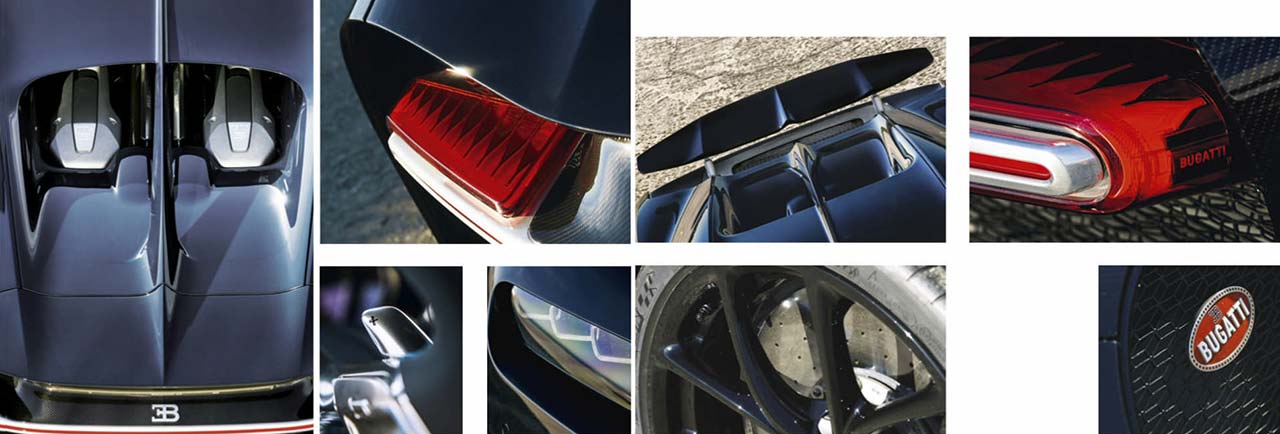
2017 Bugatti Chiron road test. Above left: huge rear aerofoil changes angle depending on whether it’s required to increase downforce for cornering, reduce drag for vmax runs, or act as an air brake to supplement the gargantuan carbonceramic discs (left). Above and above right: Bugatti offers 30 leather and eight Alcantara options for the interior, and 23 paint and eight carbonfibre finishes for the exterior, but buyers can also specify something unique – at additional cost – if Bugatti approves of the quality of the materials.
Sitting next to him at dinner, it’s clear the VW Group remains committed to Bugatti and the investment such a brand requires, even in these dark, post-Dieselgate days. He is adamant the Chiron will be more than a loss-leading halo car. He’s also emboldened by feedback from customers who, he claims, tell him ‘your car is too cheap!’ – feedback that will, in all likelihood, mean the remaining 250 cars will carry larger price tags, though how much larger remains to be seen. Finally, perhaps as a foretaste of the targets for the Chiron’s replacement (sure to be already on his engineers’ agenda) and as a daunting broadside fired across the bows of other hypercar builders, Dürheimer is certain the quest for greater power, performance and efficiency will continue: ‘‘The 500km/h barrier will one day fall. I am convinced of this,’’ he says. ‘‘It is part of human nature to cross boundaries and set new records. This striving is our driving force at Bugatti. The Chiron is the result of our efforts to make the best even better. For us, the race goes on.’’
TECHNICAL DATA FILE 2017 Bugatti Chiron
Engine 7993cc W16, quad-turbo
Power 1479bhp / 1103kW DIN @ 6700rpm
Torque 1180lb ft / 1600Nm DIN @ 2000-6000rpm
Transmission Seven-speed dual-clutch, all-wheel drive, rear LSD
Suspension, front and rear Double wishbones, coil springs, adaptive dampers
Brakes Carbon-ceramic discs, 420mm front, 400mm rear
Wheels 20in front, 21in rear
Tyres 285/30 R20 front, 355/25 R21 rear
Weight 1995kg
Power-to-weight 753bhp/ton / 553kW/tonne
0-62MPH / 0-100km/h 2.4sec (claimed)
Top speed 261mph / 420km/h (limited)
Basic price c$4million
Rating 5+
IT’S MORE LIKE MATTER TRANSFER THAN CONVENTIONAL ACCELERATION
IF BUGATTI REMOVED THE SPEED-LIMITER ALTOGETHER, IT WOULD TOUCH 450KM/H





